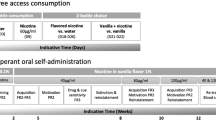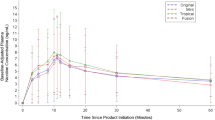Abstract
Rationale
Flavors can alter the orosensory properties of tobacco products. Specifically, flavors can serve as an oral cue for smokeless tobacco products.
Objectives
We aimed to investigate the impact of oral vanillin, the principal chemical of vanilla flavor in tobacco products, on nicotine’s taste, and nicotine choice, intake, and seeking behaviors.
Methods
Experiments were performed in young adult Sprague Dawley rats. We employed a two-bottle free-choice test (2BC) to measure the preference for different concentrations of vanillin and its effect on nicotine preference. To explore the long-term effects of early exposure to sweetened vanillin, we utilized a combined 2BC and intraoral self-administration (IOSA) model. We assessed the nicotine taking and seeking behaviors in the presence or absence of vanillin. We performed a taste reactivity test (TRT) to quantify liking (ingestive) and disliking (aversive) taste responses to oral nicotine with or without vanillin.
Results
In 2BC, female rats preferred vanillin containing solutions more than their male counterparts. In IOSA, vanillin alone and in combination with nicotine led to greater IOSA compared to water. Female rats self-administered vanillin plus nicotine more than male rats. Vanillin increased motivation to nicotine taking, but only in females. In TRT, vanillin increased nicotine’s ingestive responses but blocked aversive responses in both sexes.
Conclusions
These results indicate that vanilla flavor can increase oral nicotine intake. It can also increase liking and decrease disliking of nicotine’s taste. Furthermore, the impact of vanilla flavor on nicotine taste and nicotine choice, intake, and seeking behaviors is concentration and sex dependent.





Similar content being viewed by others
References
Bagdas D, Rupprecht LE, Nunes EJ, Schillinger E, Immanuel JJ, Addy NA (2021) Evaluation of Flavor effects on oral nicotine liking and/or disliking using the taste reactivity test in rats. Nicotine Tob Res 1–8. https://doi.org/10.1093/ntr/ntab241
Behar RZ, Luo W, McWhirter KJ, Pankow JF, Talbot P (2018) Analytical and toxicological evaluation of flavor chemicals in electronic cigarette refill fluids. Sci Rep 8:1–11. https://doi.org/10.1038/s41598-018-25575-6
Bonhomme MG, Holder-Hayes E, Ambrose BK, Tworek C, Feirman SP, King BA, Apelberg BJ (2016) Flavoured non-cigarette tobacco product use among US adults: 2013–2014. Tob Control 25:ii4–ii13. https://doi.org/10.1136/tobaccocontrol-2016-053373
Ciolino LA, McCauley HA, Fraser DB, Wolnik KA (2001) The relative buffering capacities of Saliva and Moist Snuff: implications for nicotine absorption. J Anal Toxicol 25:15–25. https://doi.org/10.1093/jat/25.1.15
Cooper M, Park-Lee E, Ren C, Cornelius M, Jamal A, Cullen KA (2022) Notes from the Field: E-cigarette Use among Middle and High School Students — United States, 2022. MMWR Morb Mortal Wkly Rep 71:1283–1285. https://doi.org/10.15585/mmwr.mm7140a3
Corrigall WA, Franklin KBJ, Coen KM, Clarke PBS (1992) The mesolimbic dopaminergic system is implicated in the reinforcing effects of nicotine. Psychopharmacology 107:285–289. https://doi.org/10.1007/BF02245149
Corrigall WA, Coen KM, Adamson KL (1994) Self-administered nicotine activates the mesolimbic dopamine system through the ventral tegmental area. Brain Res 653:278–284. https://doi.org/10.1016/0006-8993(94)90401-4
Etter JF (2016) Throat hit in users of the electronic cigarette: an exploratory study. Psychol Addict Behav 30:93–100. https://doi.org/10.1037/adb0000137
Gaby JM, Baker AN, Hayes JE (2019) Vanillin modifies affective responses to but not burning sensations from ethanol in mixtures. Physiol Behav 211. https://doi.org/10.1016/j.physbeh.2019.112668
Gellner CA, Carreño D, Belluzzi JD, Leslie FM (2023) Impact of tobacco smoke constituents on nicotine-seeking behavior in adolescent and adult male rats. Front Psychiatry 14:1–10. https://doi.org/10.3389/fpsyt.2023.1096213
Ghasemi A, Jeddi S, Kashfi K (2021) The Laboratory Rat: Age and Body Weight Matter. EXCLI J 20:1431–1445. https://doi.org/10.17179/excli2021-4072
Goldenson NI, Kirkpatrick MG, Barrington-Trimis JL, Pang RD, McBeth JF, Pentz MA, Samet JM, Leventhal AM (2016) Effects of sweet flavorings and nicotine on the appeal and sensory properties of e-cigarettes among young adult vapers: application of a novel methodology. Drug Alcohol Depend 168:176–180. https://doi.org/10.1016/j.drugalcdep.2016.09.014
Grill HJ, Norgren R (1978a) The taste reactivity test. II. Mimetic responses to gustatory stimuli in chronic thalamic and chronic decerebrate rats. Brain Res 143:281–297. https://doi.org/10.1016/0006-8993(78)90569-3
Grill HJ, Norgren R (1978b) The taste reactivity test. I. mimetic responses to gustatory stimuli in neurologically normal rats. Brain Res 143:263–279. https://doi.org/10.1016/0006-8993(78)90568-1
Hajek P, Przulj D, Phillips-Waller A, Anderson R, McRobbie H (2018) Initial ratings of different types of e-cigarettes and relationships between product appeal and nicotine delivery. Psychopharmacology 235:1083–1092. https://doi.org/10.1007/s00213-017-4826-z
Harrell MB, Weaver SR, Loukas A, Creamer M, Marti CN, Jackson CD, Heath JW, Nayak P, Perry CL, Pechacek TF, Eriksen MP (2017) Flavored e-cigarette use: characterizing youth, young adult, and adult users. Prev Med Rep 5:33–40. https://doi.org/10.1016/j.pmedr.2016.11.001
Hobkirk AL, Houser KR, Hoglen B, Bitzer ZT, Fendrich A, Bordner CR, Foulds J, Wang J, Mukherjee D, Yingst JM, Karunanayaka P, Goel R, Richie JP, Elias RJ, Yang QX (2021) Evidence from an fMRI study that dessert-flavored e-cigarettes engage taste-related, but not smoking-related, brain circuitry for female daily smokers. Exp Clin Psychopharmacol. https://doi.org/10.1037/pha0000488
Ishihara Y, Sakai N (1999) Images of the taste and smell of foods: cognitive psychophysical approaches. Chem Senses 24:226
Keast DR, Fulgoni VL, Nicklas TA, O’Neil CE (2013) Food sources of energy and nutrients among children in the United States: National Health and Nutrition Examination Survey 2003–2006. Nutrients 5:283–301. https://doi.org/10.3390/nu5010283
Kim H, Lim J, Buehler SS, Brinkman MC, Johnson NM, Wilson L, Cross KS, Clark PI (2016) Role of sweet and other flavours in liking and disliking of electronic cigarettes. Tob Control 25:ii55–ii61. https://doi.org/10.1136/tobaccocontrol-2016-053221
Kostygina G, Glantz SA, Ling PM (2016) Tobacco industry use of flavours to recruit new users of little cigars and cigarillos. Tob Control 25:66–74. https://doi.org/10.1136/tobaccocontrol-2014-051830
Kroemer NB, Veldhuizen MG, Delvy R, Patel BP, O’Malley SS, Small DM (2018) Sweet taste potentiates the reinforcing effects of e-cigarettes. Eur Neuropsychopharmacol 28:1089–1102. https://doi.org/10.1016/j.euroneuro.2018.07.102
Leventhal AM, Goldenson NI, Barrington-Trimis JL, Pang RD, Kirkpatrick MG (2019) Effects of non-tobacco flavors and nicotine on e-cigarette product appeal among young adult never, former, and current smokers. Drug Alcohol Depend 203:99–106. https://doi.org/10.1016/j.drugalcdep.2019.05.020
Lisko JG, Stanfill SB, Watson CH (2014) Quantitation of ten flavor compounds in unburned tobacco products. Anal Methods 6:4698–4704. https://doi.org/10.1039/c4ay00271g
Martín-García E, Barbano MF, Galeote L, Maldonado R (2009) New operant model of nicotine-seeking behaviour in mice. Int J Neuropsychopharmacol 12:343–356. https://doi.org/10.1017/S1461145708009279
Oliveira-Maia AJ, Stapleton-Kotloski JR, Lyall V, Phan T-HT, Mummalaneni S, Melone P, DeSimone JA, Nicolelis MAL, Simon SA (2009) Nicotine activates TRPM5-dependent and independent taste pathways. Proc Natl Acad Sci 106:1596–1601. https://doi.org/10.1073/pnas.0810184106
Palmatier MI, Smith AL, Odineal EM, Williams EA, Sheppard AB, Bradley CA (2020) Nicotine self-administration with Tobacco Flavor additives in male rats. Nicotine Tob Res 22:224–231. https://doi.org/10.1093/ntr/ntz053
Picciotto MR, Zoli M, Rimondini R, Léna C, Marubio LM, Pich EM, Fuxe K, Changeux J-P (1998) Acetylcholine receptors containing the β2 subunit are involved in the reinforcing properties of nicotine. Nature 391:173–177. https://doi.org/10.1038/34413
Pritchard WS, Robinson JH, Guy TD, Davis RA, Stiles MF (1996) Assessing the sensory role of nicotine in cigarette smoking. Psychopharmacology 127:55–62. https://doi.org/10.1007/BF02805975
Rao PD, Husile N, Strasser AA, Wise PM (2018) Pilot experiment: the effect of added flavorants on the taste and pleasantness of mixtures of glycerol and Propylene Glycol. Chemosens Percept 11:1–9. https://doi.org/10.1007/s12078-017-9231-9
Rose JE, Behm FM, Levin ED (1993) Role of nicotine dose and sensory cues in the regulation of smoke intake. Pharmacol Biochem Behav 44:891–900. https://doi.org/10.1016/0091-3057(93)90021-K
Sakai N, Kobayakawa T, Gotow N, Saito S, Imada S (2001) Enhancement of sweetness ratings of Aspartame by a Vanilla odor presented either by Orthonasal or Retronasal routes. Percept Mot Skills 92:1002–1008. https://doi.org/10.2466/pms.2001.92.3c.1002
Sengupta P (2013) The laboratory rat: relating its age with human’s. Int J Prev Med 4:624–630
Soule EK, Lopez AA, Guy MC, Cobb CO (2016) Reasons for using flavored liquids among electronic cigarette users: a concept map** study. Drug Alcohol Depend 166:168–176. https://doi.org/10.1016/j.drugalcdep.2016.07.007
Tannous S, Darlot F, Cador M, Caille S (2021) Flavor additives facilitate oral self-administration of nicotine solution in mice. Psychopharmacology 238:2235–2247. https://doi.org/10.1007/s00213-021-05848-1
Tierney PA, Karpinski CD, Brown JE, Luo W, Pankow JF (2016) Flavour chemicals in electronic cigarette fluids. Tob Control 25:e10–e15. https://doi.org/10.1136/tobaccocontrol-2014-052175
Villanti AC, Johnson AL, Ambrose BK, Cummings KM, Stanton CA, Rose SW, Feirman SP, Tworek C, Glasser AM, Pearson JL, Cohn AM, Conway KP, Niaura RS, Bansal-Travers M, Hyland A (2017) Flavored Tobacco Product Use in Youth and adults: findings from the First Wave of the PATH study (2013–2014). Am J Prev Med 53:139–151. https://doi.org/10.1016/j.amepre.2017.01.026
Wickham RJ, Nunes EJ, Hughley S, Silva P, Walton SN, Park J, Addy NA (2018) Evaluating oral flavorant effects on nicotine self-administration behavior and phasic dopamine signaling. Neuropharmacology 128:33–42. https://doi.org/10.1016/j.neuropharm.2017.09.029
Acknowledgements
We extend our sincere appreciation to Dr. Ralitza Gueorguieva, Director of Biostatistics in Department of Psychiatry at Yale School of Medicine, for their vital contribution to the robust statistical analysis, enhancing the quality of this article.
Funding
This work was supported by grant number [U54DA036151] from the National Institute on Drug Abuse (NIDA) of the National Institutes of Health (NIH) and Food and Drug Administration (FDA) Center for Tobacco Products (CTP) and the State of Connecticut, Department of Mental Health and Addiction Services. The content is solely the responsibility of the authors and does not represent the official views of the NIH, the FDA, or the Department of Mental Health and Addiction Services or the State of Connecticut.
Author information
Authors and Affiliations
Corresponding author
Ethics declarations
Conflict of interest
The authors declare no competing interests.
Additional information
Publisher’s Note
Springer Nature remains neutral with regard to jurisdictional claims in published maps and institutional affiliations.
Electronic supplementary material
Below is the link to the electronic supplementary material.
213_2024_6630_MOESM1_ESM.docx
Supplementary Material 1: Fig. 1 Randomization in two-bottle choice paradigm experiments. Fig. 2 active and inactive lever press in Vanillin intraoral self-administration Active and inactive lever presses per hour over 15 days of self-administration of water (A, B), vanillin (10 µg/ml) (C, D), and vanillin (100 µg/ml) (E, F) in female and male rats. Data were expressed as mean ± standard error of the mean (SEM) of n = 7/sex/group. *p < 0.05 indicates main effects of test solution. Fig. 3 active and inactive lever press in vanillin and nicotine intraoral self-administration Active and inactive lever presses per hour over 15 days of self-administration of water (A, B), vanillin (10 µg/ml) (C, D), nicotine (10 µg/ml) (E, F), and vanillin + nicotine (G, H), for (A) female and (B) male rats. Data were expressed as mean ± standard error of the mean (SEM) of n = 8–11/sex/group. * p < 0.05 indicates main effects of test solution.
Rights and permissions
Springer Nature or its licensor (e.g. a society or other partner) holds exclusive rights to this article under a publishing agreement with the author(s) or other rightsholder(s); author self-archiving of the accepted manuscript version of this article is solely governed by the terms of such publishing agreement and applicable law.
About this article
Cite this article
Bagdas, D., Zepei, A.M., Harris, L. et al. Impact of vanilla flavor on nicotine taste, choice, intake, and seeking behaviors. Psychopharmacology (2024). https://doi.org/10.1007/s00213-024-06630-9
Received:
Accepted:
Published:
DOI: https://doi.org/10.1007/s00213-024-06630-9




